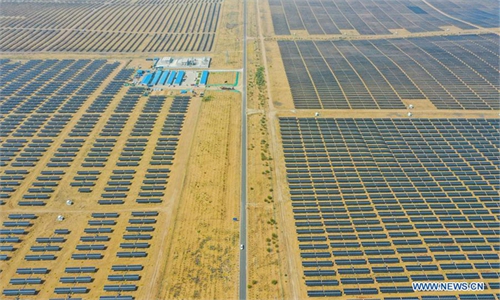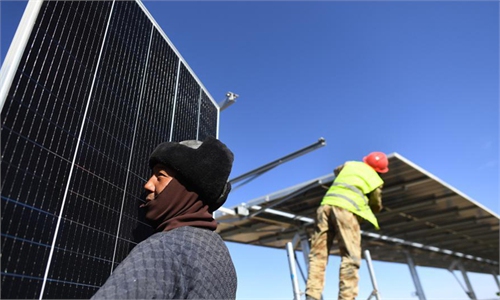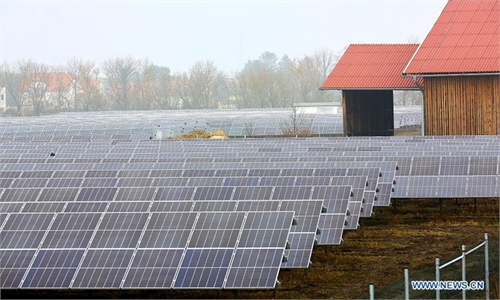Tariff, tech barriers ought to be removed to fight climate change: Chinese experts
Globalization of solar panels needed for sustainable growth: experts

Workers install photovoltaic panels at a reservoir and power station in Hefei, East China's Anhui Province, on March 4. The station aims to be generating electricity by May. Photo: cnsphoto
China's photovoltaic (PV) industry has been leading the export trend, with some companies seeing gains of 10 percent on orders from abroad, mostly European countries and the Middle East, amid strong demand for green energy as governments ramp up efforts to tackle climate change.Domestic PV suppliers that saw a significant jump in exports have become a trending topic on the popular search list of Sina Weibo, China's version of Twitter, after Chinese media reported this growth, bucking the trend of stagnant exports last year due to the pandemic.
Several PV suppliers told the Global Times on Monday that exports had shown a positive trend in the first two months of this year, with orders beginning to pile up months ago.
Ying Li Group, a leading solar energy solutions provider, told the Global Times on Monday that market demand is strong, with some orders delayed until the third quarter, mostly from European countries, Japan and India. The company plans to expand production capacity.
Another solar energy panel producer told the Global Times on Monday that it is exporting mostly to East European countries, which have seen a particular upward trend. Exports to those markets were up as much as 15 percent year-on-year in January and February this year.
Han Xiaoping, chief analyst at energy industry website china5e.com, said on Monday that growth of more than 10 percent by some Chinese PV producers is within his expectations, given the fact that China's PV capacity can cover up to 70 percent of the world's use.
Nine out of the 10 top-ranked companies in the world PV industry are based in China, representing the most advanced technology and products in the solar panel field, industry insiders said.
In addition, China's PV industry has formed a complete supply chain ranging from the manufacturing of self-developed technical equipment to the supply of raw materials needed for the products, making it possible for the industry to support the world market, according to a report that the China Photovoltaic Industry Association (CPIA) sent to the Global Times over the weekend.
To expand capacity, several Chinese companies have started mass production involving self-developed heterojunction technology (HJT) products this year, the Global Times learned.
Although HJT is not new, mass production will lift the electricity generation rate of solar panels by 20-30 percent while keeping the cost at a minimum, according to Han.
"This will not only be another big boost to the exports of China's PV products but also make it possible for more countries and regions to get access to this green energy sources in their joint battle against climate change," said Han.
Against the background of striving to achieve a carbon peak by 2030 and carbon neutrality by 2060, carbon peak and carbon neutrality have become "hot words" at this year's Two Sessions. China aims to build a green economy and pave the way for achieving its long-term carbon emissions goal by 2030, according to the Government Work Report delivered on Friday.
In 2020, China's newly installed PV capacity reached 48.2 gigawatts, the second highest in history, ranking first in the world for eight consecutive years.
Ten years ago, the market price of a PV product was 20,000 yuan ($3,062) per kilowatt, and now, through continuous technological innovation and large-scale production, Chinese enterprises have managed to lower the price to just around 1,500 yuan, making PV power generation more popular, Han said.
However, Chinese PV industry experts said that a joint effort is needed for the sustainable development of green energy.
The highly efficient battery technology that is expected to be mass produced comes from overseas, industry insiders said, noting that this brings the potential risk of intellectual property disputes to the international development of China's PV industry.
"The global battle against climate change must be supported by trade globalization involving the joint reduction of tariff and technological barriers in a bid to put limited resources to good use for all," Lin Boqiang, director of the China Center for Energy Economics Research at Xiamen University, told the Global Times on Monday.
An international standard of product verification and recognition, as well as trade policy cohesion over green energy products, need to be reinforced, said Lin.



